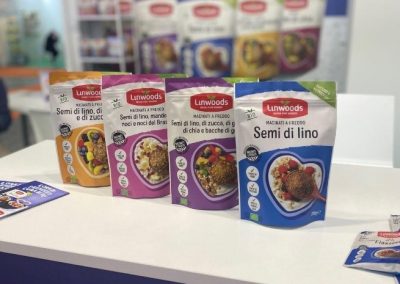From Local to Global: Linwoods Health Foods Journey of Exporting and Conquering New Markets
A Conversation with Patrick Woods, Managing Director of Linwoods Health Foods

What inspired your company to expand into exporting, and what were some of the challenges you faced in the early stages?
Our company’s inspiration to expand into export markets came from my father, John Woods, the founder of Linwoods Health Foods. John has strong experience in working with partners throughout Europe and of course the realization that our domestic market in Northern Ireland was relatively small. With only 1.8 million people in N.I., it was necessary to export in order to reach a larger customer base and achieve scale. One of the challenges we faced in the early stages was finding the right markets and partners. We conducted thorough research to select the right partners in European markets, considering factors like cultural fit, language barriers, and trade relationships. Additionally, adapting our packaging and communications strategies for different markets posed a challenge, as we needed tailored packs with different languages, and marketing to build awareness in each market.
Could you tell us about your visits to South America, Spain, and Switzerland, and what are your plans in these regions?
Our visits to South America, Spain, and Switzerland were primarily focused on trade shows, sourcing products, and strengthening relationships with customers and wholesalers. These visits allowed us to gather insights about the market, meet potential customers, and understand the latest trends and innovations in these regions. By staying updated and connected with these markets, we can effectively tailor our products and strategies to meet the demands and preferences of customers. As for our plans, we aim to continue investing in these regions, particularly in Spain, Italy, and France, to expand our presence and grow our customer base.
How do you ensure that your products meet the regulatory and compliance requirements of different countries, and what strategies have you found most effective in navigating these requirements?
Ensuring regulatory and compliance requirements is a priority for us. Within our team we have compliance expertise and a robust approval process. We closely follow regulations and work with external bodies such as the UK Food Standards Agency and the Health Food Manufacturers Association to ensure our packaging and claims meet the necessary standards. Seeking approvals and advice from these bodies helps us avoid any misrepresentation or non-compliance. Additionally, we involve multiple team members in reviewing the packaging and claims to catch any potential issues. While dealing with different countries, we acknowledge that each may have its own set of regulations. For markets like the US or countries in the Middle East or Asia, we rely on external expertise to guide us through their specific requirements.
How do you manage logistics and supply chain issues when exporting your products, and what steps do you take to minimize risks such as delays or product damage during transit?
Our team at Linwoods operate different models for managing logistics and supply chain issues based on the country or market. For countries like the UK, we directly engage with customers such as supermarkets and ensure we have stock readily available in our warehouse to fulfill orders quickly. In other markets like Spain or Italy, we work with partners who hold stock and distribute it to various platforms or depots as orders come in. This helps minimize delays and ensures efficient distribution. To minimize risks, we maintain regular communication with our logistics partners, monitor inventory levels, and implement quality control measures to prevent product damage during transit. These steps, coupled with careful planning and coordination, help us maintain a smooth and reliable supply chain. It is a team effort, and we have many skilled and experienced members working to ensure our customers are well looked after and our products are where they need to be on time.
How do you identify new markets for your products, and what criteria do you use to evaluate potential markets?
When identifying new markets, we consider factors such as the population’s disposition to buy, trends, living standards and openness to healthy foods. Primary research plays a crucial role, involving on-the-ground visits to observe shopping habits, trade shows, and engaging with shop owners. Secondary research helps us understand the market size, demographics, strength of the health food channel, competition, and the potential demand for our products. We also assess the market’s economic strength, stability and the potential customer base interested in healthy food. Based on this evaluation, we categorize markets and deploy resources relevant to our growth objectives.
What countries is Linwoods currently focused on exporting to?
At the moment, our main focus is on further developing the markets we are already present in. We have a clear strategy to expand our distribution in these markets and explore different sectors within them. Specifically, you’ll find Linwoods available in the organic/health food market and grocery channels. In the UK, for example, we are in all major grocery retailers and have a strong presence in health food stores. Similarly, in Spain, we have a significant presence in both channels. However, in France and Italy, we have less availability throughout these countries. So, our immediate goal is to strengthen our distribution in these existing markets before considering new ones.
Are there any plans to enter new markets in the near future?
While our primary focus right now is on our existing markets, we do have aspirations to expand into new territories. That said, we want to ensure that we have achieved significant growth and traction in our current markets before venturing into new ones. It’s essential for us to establish a strong presence and build export relationships in the markets we are already operating in. In the future we will consider exploring opportunities in new markets with countries already identified such as Scandinavia, Germany or perhaps Switzerland. However, any expansion plans into these new markets would be evaluated and executed after careful consideration and analysis of the potential opportunities.



